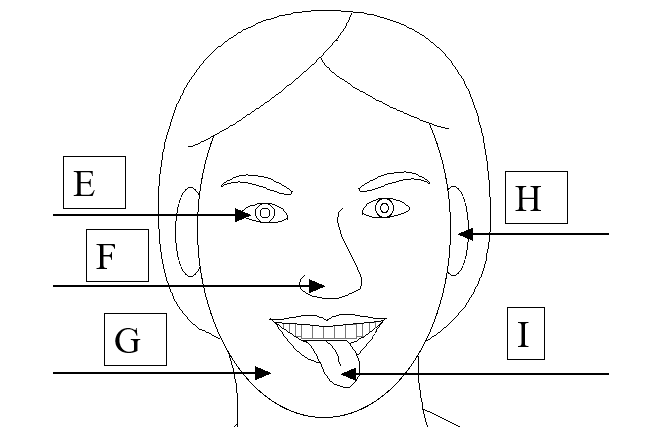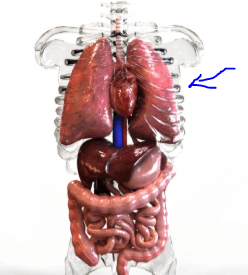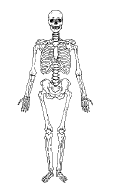Which organ senses odors in the air?
A.the lungs
B.the ears
C.the eyes
D.the nose
D. The nose takes in air and senses the odors that are in it.
The average adult human skeleton contains about 206 bones. The bones of the skeleton are located in almost every part of the body.
The skeleton is an important part of the body because it
A.supports the body.
B.helps the body move.
C.protects the organs.
D.all of these
D. All of these
The skeleton is an important part of the body because it supports the body, protects the organs, and helps the body move.
One important organ of the circulatory system is the heart. The heart's job is to
A.pump blood to other parts of the body.
B.send and receive messages from the brain.
C.help move bones so that organisms can walk.
D.break down food into tiny particles.
A.pump blood to other parts of the body.
The hearts job is to pump blood to other parts of the body. The other jobs listed are done by organs in other body systems such as muscular, digestive, and nervous.
What is the one organ that controls all of the systems of the body?
A.blood
B.heart
C.brain
D.lungs
C. The Brain
The brain and spinal cord are part of the central nervous system, which allows the human body to think, move, see, hear, taste, touch, and smell. The brain also controls all other systems of the body. Without it the digestive, respiratory, circulatory, and all other systems could not function.
The organ responsible for pumping blood throughout the body is the _______.
A.lung
B.heart
C.stomach
D.brain
B. Heart
The heart is the muscle that pumps blood throughout the body. Each time the heart contracts, blood is pushed through the body’s blood vessels, carrying oxygen, nutrients, and waste products
Look at the picture of the face below.
 Many of the sensory organs of a human are present on the face. What is the function of the sensory organ that is marked by letter E?
Many of the sensory organs of a human are present on the face. What is the function of the sensory organ that is marked by letter E?
A.detects light and sends signals to the brain
B.detects noises and aids in balance
C.detects scents and filters air
D.detects tastes and begins digestion
B. The ear detects noises and aids in balance.
The sensory organs of humans process sensory information, such as sights, smells, sounds, tastes, and touch.
The ______ is the control center of the nervous system. It sends and receives signals to and from the entire body.
A.brain
B.stomach
C.spine
D.heart
A. Brain
The brain is the control center of the nervous system. The brain sends and receives signals to and from the entire body, and it processes incoming signals. The brain is the organ that produces thoughts and allows organisms to respond to their environment.
The organ that stores urine until it can leave the body is the ________.
A.bladder
B.kidney
C.lung
D.pancreas
A. Bladder
The kidneys filter blood and send wastes down the ureters, or muscular tubes, and into the bladder. There, the wastes are stored as urine until they can be released from the body through the urethra, another muscular tube.
When riding a bicycle, what part of the body does the brain tell to move your legs in order to pedal?
A.heart
B.blood vessels
C.muscles
D.cartilage
C. Muscles
Many parts of the human body work together to enable it to move. When a movement is needed, the brain sends a signal along the spinal cord, which then transmits the signal to the necessary muscles. The muscles then work with the bones and joints to produce a movement
Michelle eats a ham sandwich. What is the first organ that digests the eaten sandwich?
A.small intestine
B.large intestine
C.stomach
D.brain
C. Stomach
The stomach is the first organ in the digestive system. It breaks down food by churning it and by using acid.
Which organ senses noises that travel through the air?
A.the mouth
B.the heart
C.the ears
D.the eyes
C. The ears catch noises that move through the air

In the human body, there are several different body systems. Each system is made up of organs that work together to perform a certain function, such as digestion.
What organ is a part of the system that helps the body move?
A.stomach
B.eye
C.liver
D.muscle
D. Muschles
Muscles, tendons, and ligaments make up the muscular system. The muscular system, along with the skeletal system, are responsible for bodily movements.
The human digestive system contains the stomach, small intestine, and large intestine.
What are structures like the stomach and intestines called?
A.organs
B.organisms
C.tissues
D.cells
A. Organs
The human body is organized. The levels of organization from smallest to largest are:
cells → tissues → organs → organ systems → organism
The stomach and intestines are organs.
What is the name of the organ pointed to by the arrow?

A.lung
B.heart
C.stomach
D.liver
A. Lung
The arrow in the picture is pointing to a lung. Lungs are part of the respiratory system.
Which of the following is the best summary for the function of the kidney?
A.The kidney filters the blood, keeping nutrients and getting rid of wastes.
B.The kidney receives the used blood of the body and sends it all to the bladder.
C.The kidney stores the blood so that it can use the nutrients.
D.The kidney processes blood, sending nutrients to the bladder to be removed.
A.The kidney filters the blood, keeping nutrients and getting rid of wastes.
The blood passing through the kidneys is filtered, separating the wastes from the needed nutrients. Then the wastes are sent to the bladder as urine, while the nutrients remain in the blood. The blood eventually gets circulated to the entire body.
Which organ senses light?
A.the stomach
B.the eyes
C.the lungs
D.the skeleton
The eyes let in light, which is how people see.
Javier saw a model of a skeleton in a science store. He counted the bones in the skeleton. There were 206.

Which is NOT something the 206 bones in our skeletons do?
a.support the body
b.help the body move
c.regulate temperature
d.protect internal organs
C. Regulate temperature
The picture above shows some of the organs of the human body. Which organ does the number 6 pointing to?

A.lung
B.kidney
C.liver
D.heart
C. The Liver
The liver is the largest organ in the body, and most of the organ is found on the right side of the human body. The liver helps to break down food and makes a chemical called bile.
The ______ breaks down large food particles into very small particles.
These small particles are absorbed into the bloodstream through the ______.
A.mouth; kidneys
B.small intestine; stomach
C.digestive system; nervous system
D.stomach; small intestine
D.stomach; small intestine
The stomach churns and mixes large food particles with acids and enzymes, breaking the food down into very small particles. These small particles then pass into the small intestine. Nutrients from the food are absorbed into the bloodstream through the walls of the small intestine.
The lungs are large organs which contain smaller, expandable sacs. These sacs greatly increase the surface area of the lungs.
Why is a large surface area important to the function of the lungs?
A.Large amounts of liquid wastes and fatty tissue must be stored in the lungs.
B.The lungs must be very sturdy and rigid so they cannot move.
C.The lungs must be able to filter oxygen from water while the organism is swimming.
D.Oxygen in air taken in by the lungs must move quickly through the lung tissue and into the blood.
D.Oxygen in air taken in by the lungs must move quickly through the lung tissue and into the blood.
The structure of organs and their function are related. For example, the lungs are large with small expandable sacs inside them. The walls of these small, thin, circular sacs allow oxygen to move quickly across them and into the blood stream.
Which of the following structures forms a protective layer between the environment and the inside of a body?
A.bone
B.skin
C.blood vessel
D.muscle
B. Skin
One of the main functions of the skin is to provide a physical barrier between the inside and outside of the body. This barrier protects the internal organs from dirt and infection, and keeps internal tissues from losing fluid to the outside.
There are three main types of muscles in the human body. Smooth muscle lines many organs, such as the stomach and intestinal tract. Cardiac muscle is found in the heart. Skeletal muscle is found near the bones of the skeleton.
What is the function of smooth muscle?
A.Smooth muscle helps keep the bones of the skeleton together and helps them move properly.
B.Smooth muscle helps to store nutrients in the body.
C.Smooth muscle helps organs to contract and move fluids and solids through them.
D.Smooth muscle is used to help the heart beat properly
C. Smooth muscle helps organs to contract and move fluids and solids through them.
Each of the three types of muscles performs a different function, although all of these functions require one main function—contracting.
The pancreas is a gland of the body that is able to do several functions.
The functions of the pancreas include
A.releasing hormones and producing enzymes to break down food.
B.mostly helping in the production of offspring.
C.pumping blood and oxygen to the other organs of the body.
D.helping to keep breathing patterns of humans normal.
A.releasing hormones and producing enzymes to break down food
The pancreas gland, which is a part of both the digestive and endocrine systems, has two main functions. It releases hormones, such as insulin, which help keep blood sugar levels even. It also produces digestive enzymes, which it then sends into the small intestine in order to help break down food.
The largest internal organ of the human body, which helps to break down food and makes a chemical called bile, is known as the _________.
A.lungs
B.bladder
C.heart
D.liver
D. Liver
The largest internal organ of the human body, which helps to break down food and makes a chemical called bile, is known as the liver.
The liver has many functions in the human body.
The liver...
- makes a chemical called bile (which breaks down fats)
- collects nutrients from blood
- helps to break down food
- helps blood to clot
The three main organs in the removal of wastes in the human body are the skin, lungs, and _______.
A.brain
B.kidneys
C.liver
D.heart
B. the Kidneys
During circulation, blood passes through the kidneys depositing unused water, minerals, and urea. The kidneys filter wastes from the blood and form urine. About 1.5 liters of urine is produced and excreted from the body each day.